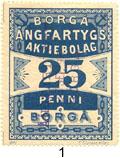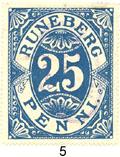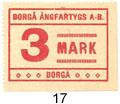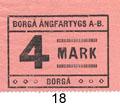(Click on an image to make it larger.)






 |
A SPECIAL OF THE STAMP
EXPERTS WEB SITE
BORGÅ ÅNGFARTYGS
AKTIEBOLAG
To the mobile version
The Borgå
Steamship Company was founded in 1891 to carry passengers and freight between Porvoo (in Swedish Borgå) and Helsinki (Sw. Helsingfors) and
to many islands of the
archipelago in between. Porvoo is situated some 50 km east of Helsinki. The
company's first ship ("s/s Borgå") was delivered in 1892. In 1896 it bought
the only ship of its older competitor on the same route, the
Borgå-Helsingfors Ångfartygs Aktiebolag (founded in 1868), which then
soon dissolved itself. From April 1893
on the two shipping companies had cooperated.
In 1926 buses had began to operate between Helsinki and Porvoo, and at the
end of 1944 the shipping company ended its service. On 7 May1945
the last remaining ship, the "s/s
J. L. Runeberg" (II), was sold for
2 500 000 mk. (This ship is, however, still sailing.) The company had lost its
other steamer (the old "Borgå") as part of Finland's war-reparations to
the Soviet Union. Now only liquid assets remained. In November 1946
H. Liljestrand
Oy, Helsinki, offered to
buy all the 2 000 BÅAB shares at 2 700 mk each. 1947 to 1948 BÅAB owned the
m/s
"Lideborg" and may have owned other motor vessels too, but at least
from 1952 on the company had no activities at all. Due to credit losses the
share capital was almost used up in 1959 and had to be increased. Then
nothing more was heard from
BÅAB
(more information, in Finnish).
In 1900 the largest shareholders were Johan Askolin 12 %, G. L. Söderström 7
% and Erik Söderström 3.6 %, and in 1944 Carl Johan Askolin 13.5 %, Torsten
Modeen 7 and Gösta Kyntzell (the managing director) 5 %. In 1947 the Holger
Liljestrand family owned 78 % of the shares. At far below is a
picture of a share certificate from 1928.
Certificates of the 1896 and 1919 issues have also been preserved and are
of the same design.
From at least 1893* on the Borgå Ångfartygs Ab issued large size stamps
(fraktmärken or paketmärken) for use on parcels
carried by its ships. The stamps of the first period (examples
illustrated at left) are all uncommon in spite of the considerable
number sold. All but one of the designs are actually identical with or
similar to those
of the older shipping company's stamp (the "B-H" stamps at right, first issued in 1894?), but in different colours
or with other inscriptions. The stamps of this type were in use until 1918 or 1919.
During the second period, from 1919 or 1920 onwards, three simple labels of the
type at right were produced as stamps for parcels. The 1 mk and 2 mk in
brown were obviously in use until 1922 only. Probably in 1923 the 1 mk brown was
replaced by the same design in black. But the 3 mk stamp continued in use until 1925.
A 4 mk was added to the denominations in 1923, and a 1.50 mk in 1925 or
1926.
The numbers below the clickable thumbnails at left and at right are
according to Connell. If you hover the cursor over an image you will see
the stamp's number according to the Sundman catalogue as a tooltip. No. 9 (Sm. 9) is
typographed, all other stamps up to no. 13 (Sm. 19) are lithographed. Of the
second period labels at least nos. 16 to 19 are typographed. The
sheet make-up of the 1.50 mk is very peculiar.
A detailed breakdown of quantities sold for each denomination 1895 to
1927 is available here as a PDF file.
The minutes of the meetings of the board are still in the
archives, but there is no information regarding the prices charged by the
company for parcels (and letters). Nor is there any other list of rates in the papers
left (nor published in Borgåbladet during 1919). It is presumed that preserved envelopes with stamps had
originally been attached to parcels, as 25 p postage is too much for a
letter (compare the rates on p. 108 in Connell).
In the 19th century freight represented about half of BÅAB's total income,
of which less than 5 % was accounted for in stamps, most of the freight
portion being by bills of lading. Stampless letters are also known; for B-H
too. (Later on proceeds from passengers increased
vastly in importance.) In spite of the strong inflation that started in 1916
the freight income paid by stamps developed very poorely in the post-WW1 years.
In 1925 to 1927 the sale collapsed and is after that no longer mentioned in
the company's financial records. We may thus assume that stamps were
not used after 1927. Unused labels of the last issue (1 mk black, 1.50, 3
and 4 mk) are plentiful.
The Borgå Ångfartygsaktiebolag's financial records for 1943 once again include "parcel stamps". The
denominations are as follows (number sold in brackets): 2 mk (83), 3 mk (8),
4 mk (11), 5 mk (1921), 6 mk (4), 7 mk (7), 8 mk (23), 9 mk (0), and 10 mk
(5700). However, for 1944 the the term "paketmärken" is altered to
"godsbiljetter" (freight tickets), without any breakdown. Obviously these
were not postage stamps. No copies are known.
*A Borga
Angfartygs Ab stamp (of
the no. 1 and 2 type at top left) is known cancelled Sept. 1893, but 1895 is the first
year that sale of stamps appears in the company's financial records. In 1895
(and before) the BÅAB stamps could only have been inscribed "Borgå". It is a fact that the older competitor,
the Borgå-Helsingfors Ångfartygs Ab (cf. above), used parcel stamps on board
its "Runeberg". This ship was bought in Feb. 1896 by BÅAB, which continued using the old stamp
design (in new colours). This paddle steamer was sold in 1900, before
the navigation season started.
BÅAB's own ship "Borgå" was delivered in June 1892 (and may have immediately been
supplied stamps), and the "Helsingfors" in June 1901 (sold in Feb. 1916,
after having repeatedly been laid up). The design of the stamps issued for
these two ships are very similar to the Runeberg stamp. (For accounting
purposes each of these two ships had their own stamps.) A new ship, the "J.
L. Runeberg" (I) was delivered in June 1914. The latter was sold in early
1937 and replaced by the new acquisition "J. L. Runeberg" (II, formerly
"Helsingfors Skärgård").
Literature:
The company archives (up to 1946), now kept in the Museum of Porvoo.
The company's first 50 years, in the magazine Suomen merenkulku, 1942:1.
G. W. Connell. The Private Ship Letter Stamps of the World, Part 4.
Forssa 1993. Pp. 110–120.
D. A. Dromberg in Suomen postimerkkien käsikirja, VI. Mikkeli 1972. Pp. 90–98.
Sulo Kinnunen. Suomen laivapostimerkit. Suomen Filatelistiseura, Helsinki
1930.
Valter Lindroos. Borgå Ångfartygs Aktiebolag 1891–1941. En historik. Borgå 1941.
T. Malmberg. M/s J. L. Runeberg. Saaristolaiva sydämissämme 1912–2012. 2012.
(Also in Swedish.)
Jacobus Sundman. Priskatalog över Finlands båtpostmärken 1867–1933. Helsingfors
1993.
Other short
monographs:
Järnvägs Ab Fredrikshamn,
Companhia de Moçambique,
Some Near East Islands.
A few facts about
Wanajavesi Ångbåtsbolag.
Copyright ©
2005–2011 by G.
Kock
Contact
information here. Page address:
www.filatelia.fi/articles/borga.html

|
(Click on an image to make it larger.)







1896 share certif. |














